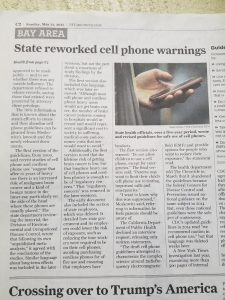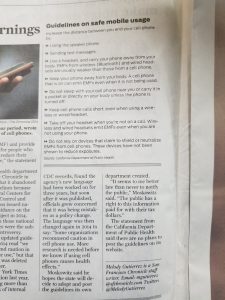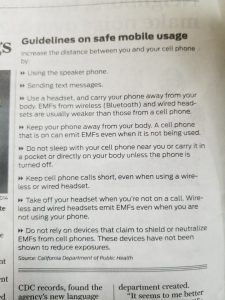Category: Hot Topics
President Lyndon Johnson talking about Controlling the Weather in 1962.
TSA – RESTRICTIONS for TRAVEL without Approved Identification . . . and which States are in TROUBLE. . .
TSA to stop accepting driver’s licenses from 9 states in 2018
COLUMBUS (WCMH) — The Transportation Security Administration is starting to post signs at airports nationwide warning travelers to make sure they have the right identification to board planes.
You might think that means you just need you driver’s license, and for Ohioans, you’d be correct. But residents of nine states will be forced to alternative identification, such as passport, military ID or permanent-resident card, if they want to fly anywhere in the US next year.
Those nine states? Kentucky, Maine, Minnesota, Missouri, Montana, Oklahoma, Pennsylvania, South Carolina and Washington.
 The issue is with the Department of Homeland Security’s Real ID act, which was passed by congress and signed into law by President George W. Bush in 2005. It requires states to adopt better security measures for driver’s licenses to help prevent terrorism.
The issue is with the Department of Homeland Security’s Real ID act, which was passed by congress and signed into law by President George W. Bush in 2005. It requires states to adopt better security measures for driver’s licenses to help prevent terrorism.
Ohio already adopted those measures, but the nine states listed above still don’t have IDs that comply with federal regulations. Those regulations require driver’s licenses to contain anti-counterfeit technology and require states to thoroughly verify an applicant’s identity.
“ID requirements are changing,” signs going up at airports state. “Starting January 22, 2018, you will need a driver’s license or ID from a state compliant with the Real ID Act.”
It doesn’t just stop at the airport. Residents of those states would also need alternative identification to access any Federal facilities or nuclear power plants.
It’s unclear if state legislatures will update their identification standards by that deadline. Some states, such as Montana, oppose the Real ID act, saying the program “raises real concerns about the unnecessary collection of Montanans’ personal and private information by the federal government.”
INTERACTIVE MAP: See if your state is compliant
Explosive Article: The Pentagon Bio-weapons
Energy Commission Adopts Lighting Standards to Save Californians More Than $4 Billion in Electricity Costs
For Immediate Release: January 27, 2016
Media Contact: Amber Pasricha Beck – 916-654-4989
SACRAMENTO – The California Energy Commission today adopted first-in-the-nation energy standards for the next generation of light bulbs. The standards cover small-diameter directional lamps, often used in track lighting, and general purpose light-emitting diodes – commonly called LEDs – used to replace typical existing home lighting.
With these new standards, consumers will save more than $4 billion in aggregate over the first 13 years and conserve enough electricity to power all of the households in Santa Barbara and Ventura counties (about 400,000 average homes). Bulbs that meet the new standards are already available to consumers.
The adopted standards will save consumers money in both electricity and bulb replacement costs. For a $4 investment in the more efficient small-diameter directional lamps, the Energy Commission estimates consumers will save nearly $250 in reduced energy and bulb replacement costs when averaged over 11 years. The lifetime savings for general purpose LEDs range from $4.50 to $12 and will likely grow as purchase prices continue to decline.
Small-diameter directional lamps
Small-diameter directional lamps are often used at commercial sites, such as stores and museums, for track lighting. In California, about 16 million of these bulbs are in use. The standards cover bulbs with a diameter of 2.25 inches or less and will go into effect January 1, 2018. The standards include:
- A requirement that bulbs have either an efficacy greater than or equal to 80 lumens per watt or a color rendering index + Efficiency score of at least 165 with a minimum efficiency of at least 70 lumens per watt.
- A minimum lifetime of 25,000 hours for each product. LED bulbs are the only products that meet this lifetime standard. The adoption is expected to cause a transition to LEDs from less efficient technologies.
LEDs
The standards for general purpose LEDs include omnidirectional, directional, and decorative bulbs, as well as LEDs designed for retrofitting the covered socket types. LED bulbs consume less energy than other types of light bulbs and have a longer lifespan, making the lifetime energy savings far greater than the incremental cost.
The standards for LEDs include efficiency and quality improvements to initially take effect January 1, 2018. Additional amendments to strengthen efficiency and limit power in standby mode take effect July 1, 2019. The standards include:
- A requirement for omnidirectional bulbs to produce a light distribution pattern that aligns with requirements adopted by the U.S. Environmental Protection Agency’s (EPA) ENERGY STAR® program for bulbs.
- A minimum lifetime requirement of 10,000 hours, equivalent to a ten year life in a typical home.
- Limitations on how distorted a particular color appears under the bulbs.
- A requirement of manufacturers to meet minimum performance thresholds before making claims about dimmability or other qualities.
- A limit to the amount of power a connected LED can use in standby mode.
For more information please see the frequently asked questions on the lighting standards.
Other actions
The Energy Commission also approved the revised California Energy Demand 2016-2026 Electricity Forecast. The report is a baseline of consumption and peak demand for California. Overall, staff found that electricity use has slightly decreased compared to the 2014 forecast update. The findings also support a greater decrease in electricity sales and peak demand because of the increase in home solar systems. This report is used by the California Public Utilities Commission for long-term procurement planning and the Independent System Operator for transmission planning.
# # #
The California Energy Commission is the state’s primary energy policy and planning agency. The agency was established by the California Legislature through the Warren-Alquist Act in 1974. It has seven core responsibilities: advancing state energy policy, encouraging energy efficiency, certifying thermal power plants, investing in energy innovation, developing renewable energy, transforming transportation and preparing for energy emergencies.
PG&E wants ratepayers to pay California wildfire costs
Fearing billions of dollars in future liability, PG&E has been aggressively urging state regulators to make it easier for the company to charge ratepayers — rather than its shareholders — when its power lines and other electrical equipment cause wildfires.
Top PG&E executives met as recently as last week to lobby officials at the state Public Utilities Commission in San Francisco over the issue, which could arise powerfully in coming months if the utility is found to be responsible for the Wine Country fires, a serious possibility that state regulators are now investigating.In a 30-minute meeting on Oct. 17, Meredith Allen, PG&E’s senior director of regulatory relations, told Travis Foss, an adviser to PUC Commissioner Clifford Rechtschaffen, that PG&E and other California utilities are in “an untenable situation,” according to a record of the meeting that PG&E sent to the PUC as required under state lobbying rules. PG&E should not have to pay “a disproportionate” share of the costs of wildfires because of the growing fire risk and a tough insurance market, Allen argued.
But consumer groups say the push by PG&E and the state’s other two large utilities — Southern California Edison and San Diego Gas & Electric — is out of line. If the PUC allows utilities to pass along most of their uninsured wildfire costs to ratepayers in the form of higher monthly bills, critics say, they will have less incentive to properly maintain wires, trim back trees and take other sometimes costly measures needed to reduce wildfire risk.
“PG&E and the other utilities are very vigorously lobbying to see that the costs of disasters be covered by ratepayers, even when they are found negligent,” said Mark Toney, executive director of The Utility Reform Network, a San Francisco consumer group.
“The shareholders benefit when the company does well,” he said. “They have to pay when the company doesn’t do well.”
If the PUC doesn’t grant the utilities’ request to spare shareholders if the companies are held liable for causing wildfires, they would see their profit margins decrease — which is likely to hurt shareholders financially by causing dividends and utility stock prices to drop.

The PUC and Cal Fire are investigating whether PG&E power lines were responsible for starting the devastating wildfires in Napa and Sonoma counties earlier this month. The Bay Area News Group reported two weeks ago that records from emergency dispatchers show that firefighters were sent to at least 10 different locations in Sonoma County to respond to reports of arcing power lines and exploding transformers on the night of Oct. 8 within 90 minutes of the first fire being reported.
If PG&E is found to be at fault for the fires, the costs would almost certainly soar into the billions. But the company has reported that it has only $800 million in insurance.
The fires in Napa, Sonoma and other Northern California counties together were the deadliest and most destructive in state history. They burned more than 245,000 acres, destroyed at least 8,700 structures and killed 42 people, according to Cal Fire.
The PUC has ordered PG&E to preserve all lines, power poles, emails and other evidence that could be relevant in the case. PG&E’s stock price has fallen 18 percent from the time the fires began until Thursday.
The specific case that has drawn PG&E’s recent focus is a potentially precedent-setting PUC proceeding regarding whether San Diego Gas & Electric should be forced to pay $379 million in expenses that its insurance did not cover after the utility’s power lines were blamed for starting three huge fires in San Diego County in 2007. The outcome of that San Diego County case is “likely to impact PG&E directly in the future,” PG&E attorney Michael Klotz said Oct. 4 in a filing with the PUC.
“Wildfires and the method with which they are treated presently have real world and potential long-term impacts on the operations, risk management and financial standing of every energy company in the state,” PG&E spokesman Donald Cutler said in an email. “We felt it was important that the Commission hear the perspectives of all the energy companies that operate in California.”
But the San Diego County case is not going the utilities’ way.
On Aug. 22, after more than a year of hearings and motions, two administrative law judges rejected San Diego Gas & Electric’s request to pass along $379 million in uninsured expenses from the 2007 fires to its ratepayers. A final decision in the case by the five-member PUC, whose members are appointed by the governor, has been postponed three times, with a decision now scheduled for Nov. 9.
The three San Diego County fires have similarities to this month’s North Bay fires.
Investigators from Cal Fire and the PUC concluded that the three October 2007 blazes — the Witch, Guejito and Rice fires — were caused by San Diego Gas & Electric’s power lines.
The Witch and Guejito fires combined to burn 197,000 acres. They killed two people, injured 40 firefighters and destroyed 1,141 homes and 239 vehicles. The Rice fire burned 9,472 acres and destroyed 206 homes. It was caused by a dead tree limb falling on power lines.
The PUC ruled that the utility did not trim trees back as required by state law in the Rice fire — and that the utility was at fault in the other two. In the Witch fire, the power line that caused the fire shorted three times in three hours, investigators found, and it took the utility more than six hours to turn off its electricity.
After the fires, San Diego Gas & Electric faced $5.6 billion in legal claims. It settled approximately 2,500 lawsuits from people who suffered damages, bringing its costs down to $2.4 billion, said company spokeswoman Colleen Windsor. The $379 million it is seeking to charge ratepayers for now is money not covered by its insurance.
Windsor said that “hurricane force” wind speeds topped out at 92 mph on the day of the fires.
“We design, operate and maintain our system at or above standards, and despite having a safe system the wildfires that occurred were due to circumstances beyond SDG&E’s control,” she said.
In August, however, the two administrative law judges disagreed. They sided with consumer groups’ experts who said the winds were blowing at 43 mph at the time of the Witch fire’s ignition, 56 mph at the time of the Guejito’s fire’s ignition and 34 mph when the Rice fire started. The judges, S. Pat Tsen and Sasha Goldberg, concluded that SDG&E “did not reasonably manage and operate its facilities” and thus could not pass along costs to ratepayers.
PG&E made similar claims this month after the North Bay fires, saying that “hurricane strength” winds of more than 75 mph were in play. But the Bay Area News Group reported earlier this month that weather stations in the Santa Rosa and Napa area recorded wind speeds of 30 and 32 mph when the fires started, although the winds later strengthened.
Consumer groups and the utilities are watching the San Diego case very carefully.
“We’re concerned this could give a free pass to the utilities,” said Diane Conklin, an activist in San Diego. “If the utility doesn’t have a good record, then their insurance costs are going to be higher, like the bad boy in the driving class. But they should have some accountability. They should have consequences for their own actions.”
The H3N2 flu virus is known as the hospitalizer. Here’s why.
The H3N2 flu virus is known as the hospitalizer. Here’s why.

Stay home. Don’t go to work. Keep sick children out of school.
That’s some of the stern advice California health officials offered to people and their loved ones suffering from coughs, sneezes, aches and fevers as a result of the flu circulating at elevated levels throughout the state. Health officials also continued to urge the public to get vaccinated.
The advice came a day after a state epidemiologist told reporters that this could be the worst influenza season since 2009, when the H1N1 or Swine flu pandamic killed 12,469 people nationwide.
At a news conference at their downtown Los Angeles office, county public health officials said it was not too late to get the flu vaccine, since they said it perfectly protects against three of four of the strains circulating. They also said that because the flu season started a month earlier than usual and its peak has yet to be identified, the bug could circulate for a longer period of time.
“We’ve seen an elevation in the number of outbreaks that have been reported to us from nursing homes and other congregate living facilities,” said Dr. Sharon Balter, director of acute communicable disease control for Los Angeles County. “All this points to an earlier and somewhat more severe flu season this year than last year.”

The numbers tell the story best, Balter added:
• Greater Bay Area region has reported 7 deaths. There have 36 deaths in Los Angeles County, compared to 17 last year. .
•The number of emergency department visits of people complaining of flu like symptoms is 130 percent higher compared to the same time last year.
•The number of people who are testing positive for influenza is at 50 percent compared to 17 percent last year.
•The circulation of Influenza A H3N2 means more hospitalizations and deaths.
That last point is what concerns public health officials most because its the strain that’s challenging this year’s vaccine, which doesn’t fully protect against H3N2.
Here’s why H3N2 is most concerning:
Influenza A H3N2 is what’s known as “a non-human influenza virus that normally circulates in pigs,” according to the federal Centers for Disease Control and Prevention. In 2011, H3N2 was detected, and it turned out to be a whopper, because it contained genes from avian, swine and human virus, as well as the 2009 H1N1 gene, according to the CDC. Infected pigs can spread it to humans in the same way humans get it from each other: coughs and sneezes and infected droplets that are inhaled.
In general, influenza viruses are always mutating, but the H3N2 virus is especially cunning, some scientists say. It’s not an alien shape shifter, but some scientists say it mutates so quickly so that vaccine makers can’t quite catch up to it.
 Claudia Pfeil, MD, examines Charles Lin, of Alhambra, who has the flu symptoms at Pasadena Urgent Care Health Care Partners in Pasadena Friday, January 5 2018. A wave of flu has gripped Southern California. LA County is seeing widespread influenza which means emergency rooms and urgent cares are packed. (Photo by Walt Mancini/Pasadena Star-News/SCNG)Like our Facebook page for more conversation and news coverage from the Bay Area and beyond.
Claudia Pfeil, MD, examines Charles Lin, of Alhambra, who has the flu symptoms at Pasadena Urgent Care Health Care Partners in Pasadena Friday, January 5 2018. A wave of flu has gripped Southern California. LA County is seeing widespread influenza which means emergency rooms and urgent cares are packed. (Photo by Walt Mancini/Pasadena Star-News/SCNG)Like our Facebook page for more conversation and news coverage from the Bay Area and beyond.
While H3N2 can cause more severe illness among those age 65 and older and people with underlying medical conditions, it poses a threat to children, according to the CDC, because children born after 2001 have little to no immunity against it.
There have been no infant or young child deaths reported in the Bay Area or Los Angeles County, but among the 36 people who have died so far in L.A., the mean age was 74 years old.
So why doesn’t the California Health Department report flu-related deaths among those 65 and older?
On Tuesday, state officials said there were 27 flu-related deaths in California, not including those who are 65 years or older. Meanwhile, San Diego County reported 91 deaths total. The discrepancy is startling.
California health officials don’t report deaths of those 65 and older, because they are not required to, and they are most focused on how the virus acts on children and those deemed middle aged, said Dr. Jeffrey Gunzenhhauser, Los Angeles County’s interim health officier.“Here in LA County, we’re a pretty resource rich community, so it’s not that much of a burden,” to get that information from laboratories, physicians, and hospitals, Gunzenhauser said.
“We want to know all the deaths in Los Angeles County,” he added.
“We do have a lot of elderly and we have a lot of nursing homes,” said Dr. Barbara Ferrer, director for the Los Angeles County Department of Public Health. “It’ really is important for us to understand the full spectrum of how influenza activity is affecting our residents.”
HOW TO TREAT THE FLU
- If your symptoms are mild, take care of yourself at home rather than going to your doctor.
- Rest will help you recover sooner and reduce your risk of additional infections such as bacterial pneumonia, sinusitis, or ear infection.
- Sip broth, herbal tea, and other non-alcoholic liquids to soothe your throat and relieve congestion.
- If you smoke, now is a good time to quit. Smoking can irritate your throat and make your cough worse.
- Take acetaminophen (Tylenol, others) or ibuprofen (Advil, Motrin IB, others) to reduce fever and muscle aches.
- Stay home from work, school, and other public places for at least 24 hours after your fever is gone to avoid infecting others.
SOURCE: Kaiser Permanente
WATER ALERT! Global High-Level Panel on Water and Peace – Secretariat | Geneva Water Hub
The Global High-Level Panel on Water and Peace was launched on 16 November 2015 in Geneva with the task of developing a set of proposals aimed at strengthening the global framework to prevent and resolve water-related conflicts, and facilitate the use of water as an important factor of building peace and enhancing the relevance of water issues in national and global policy making.
15 countries have co-convened the Panel: Cambodia, Colombia, Costa Rica, Estonia, France, Ghana, Hungary, Jordan, Kazakhstan, Morocco, Oman, Senegal, Slovenia, Spain, Switzerland.
The issue of “Water and Peace” has many facets. The Panel was asked to focus on four main themes:
- Identify legal, economic, financial and institutional mechanisms to incentivize multi-sectoral and transboundary water cooperation;
- Examine how to cope with and prevent water-related conflicts, namely transboundary and inter-sectoral — possibly exploring potential mechanisms to promote hydro-diplomacy;
- Promote effective implementation of the global water conventions;
- Promote best practices in water cooperation.
Read more “WATER ALERT! Global High-Level Panel on Water and Peace – Secretariat | Geneva Water Hub”
NOT TRUE: Santa Rosa faces bleak budget forecast following October wildfires – all cities have been “stealing and hiding” taxpayer revenue in CAFR = Doubling Bookkeeping.
Santa Rosa faces bleak budget forecast following October wildfires, they say BUT all cities have been “stealing and hiding” taxpayer revenue in the CAFR = Doubling Bookkeeping . . .
COMMENT: All cities and counties have been “stealing and hiding” taxpayer revenue along with other corporate agencies, Dept. of Education, Public Health, Social Services agencies (and many mor.).
Our cities are incorporated and DO NOT SERVE US. They are serving agendas of foreign international corporations. Through clever deceptive bookkeeping practices city revenue has been stolen by a double set of bookkeeping practices and diverted into large national and international corporations. The cities and others skim off millions, billions and trillions.
revenue into secret accounts. The money is NOT used for our infrastructure or our communities . . . Rather our corporate government agencies has been engaged in money laundry.
SkyEye™ LED Street Light Systems – Clearly InSight IP

SKYEYE™ is a complete LED Street Light and Parking Lot Light System with optional features including super bright LED lights, plug & play wireless controls, active motion sensing, and a top-rated video security camera.
SKYEYE™ provides the necessary light to illuminate the surrounding area to capture high resolution, full color video at night and during the day – and provides 360º coverage for observation and surveillance.
SKYEYE™ cameras are extremely discreet, managing their task with a single lens. The advanced flexible design can be a standard off-the-shelf unit or a customized solution that fits your security needs.
Read more “SkyEye™ LED Street Light Systems – Clearly InSight IP”
MOST IMPORTANT: MajestyTwelve Disclosed by William Cooper who wrote Behold a Pale Horse . . .
http://www.hourofthetime.com/majestyt.htm
MAJESTY
TWELVE
by William Cooper
Veritas News Service – The following is fact. It is not a theory it is a genuine conspiracy. I witnessed the Top Secret/Majic documents from which this information is excerpted while a member of the United States Navy attached to the Intelligence Briefing Team of Admiral Bernard Clarey, Commander in Chief of the United States Pacific Fleet.





